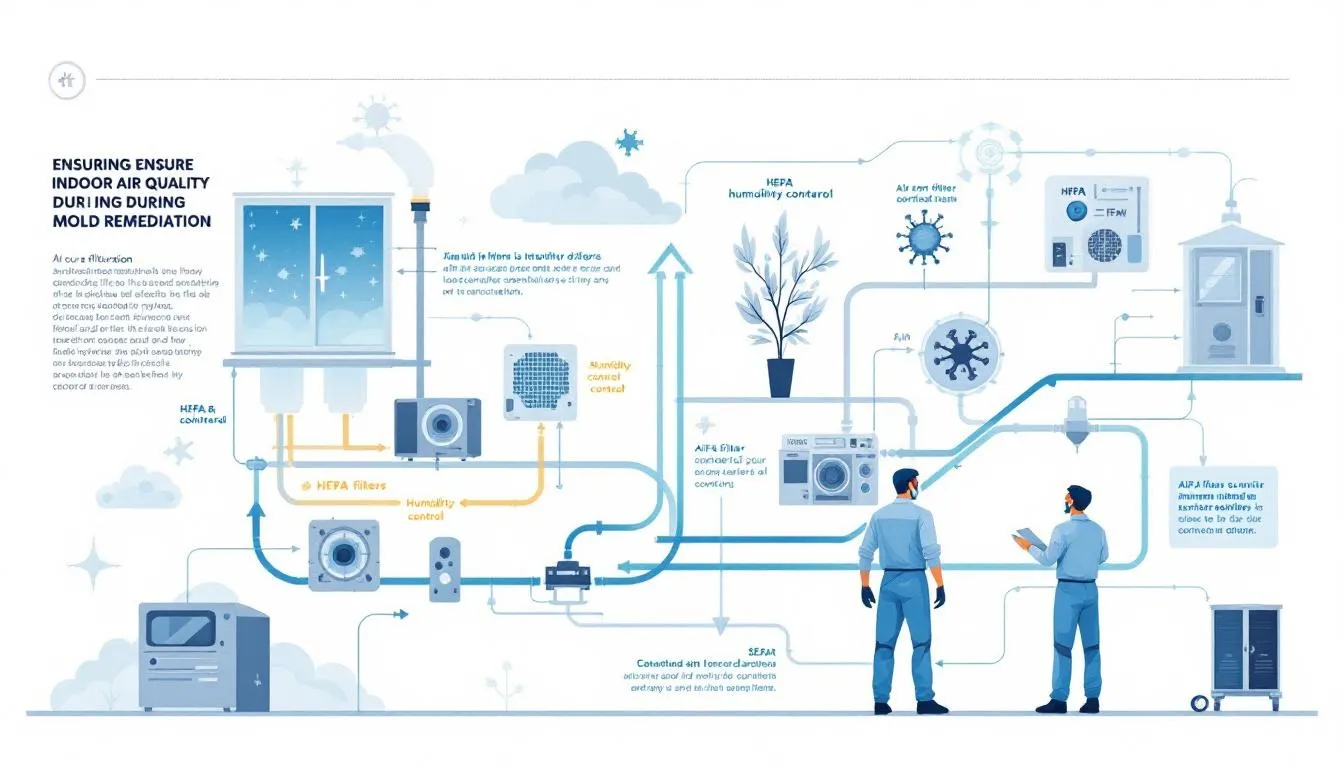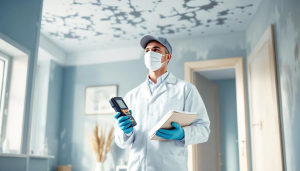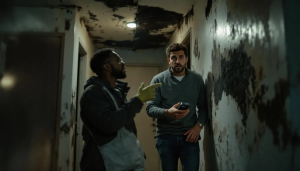Facing mold problems and not sure what to do? A mold assessment consultant can accurately evaluate the extent and type of mold in your home. This article delves into why consulting a mold expert is crucial and what to expect when you hire one.
Key Takeaways
Hiring a certified mold assessment consultant ensures accurate identification of mold types and levels, leading to effective remediation and prevention of costly health and property issues.
A comprehensive mold inspection process includes moisture measurement, air sampling, and a detailed report that guides targeted remediation strategies.
Understanding the distinct roles of mold assessment consultants and remediation contractors is essential; consultants focus on assessment and protocol development, while contractors carry out the cleanup.
Importance of Hiring a Licensed Mold Assessment Consultant

When it comes to mold, not all inspections are created equal. Hiring a licensed mold assessment consultant ensures that you get the most accurate identify of mold types and levels, which is crucial for effective remediation. Unlike DIY methods, professional inspectors adhere to stringent standards, guaranteeing reliable and trustworthy results.
Undetected mold can wreak havoc on your home’s structural integrity, leading to expensive repairs and safety hazards. Investing in professional mold testing might seem like an added expense, but it can ultimately save you money by preventing health-related costs and extensive property damage. Licensed mold assessment consultants bring expertise, advanced tools, and a thorough approach that DIY methods can’t match.
Moreover, professional mold inspectors provide a detailed report that not only identifies mold but also highlights potential moisture sources that contribute to mold growth. This comprehensive approach ensures that you address the root cause of the problem, preventing future mold issues and safeguarding your property and health.
Comprehensive Mold Inspection Process

A comprehensive mold inspection starts with a non-invasive visual examination of accessible systems within the building. This initial step helps in identifying visible mold growth, moisture intrusion, and conditions that could promote mold proliferation. The use of moisture meters and thermal imaging further assists in pinpointing hidden moisture sources, which are often the culprits behind mold growth.
The verification process involves air sampling and surface sampling to evaluate mold levels indoors compared to outdoor conditions. Surface samples are collected to determine if visible growth is indeed mold and to assess its impact. This meticulous approach ensures that all potential mold contamination is accurately identified and documented.
Equally important are the measurements of:
moisture
temperature
humidity These are integral to the mold inspection process. These measurements help in understanding the environmental conditions that favor mold growth and assist in developing targeted remediation strategies to a certain extent. Inspectors must report any moisture intrusion and conditions that may promote mold growth, ensuring a thorough assessment.
Finally, the inspection culminates in a comprehensive written report that details the findings, including the causes of mold growth and recommended remedial actions. This report serves as a vital tool for property owners, providing a clear roadmap for effective mold remediation and prevention.
Developing a Mold Remediation Protocol
Developing a mold remediation protocol is a critical step in protecting property owners and ensuring the proper execution of mold removal. A licensed mold assessment consultant is responsible for preparing this protocol, which includes detailed recommendations based on the inspection report. The report typically outlines the type and level of mold found, affected areas, and specific mold damage remediation actions needed to write protocols effectively.
When remediation is necessary, the consultant provides a written protocol for licensed remediation contractor to follow. This document acts as a guide, ensuring that all remediation efforts are thorough and effective. A Project Manager is usually assigned to oversee the remediation process and maintain communication with the client throughout the project.
Obtaining permits for mold remediation work is typically the client’s responsibility unless specified otherwise. The protocol also addresses common reasons for failing a clearance test, such as unresolved moisture issues and incomplete physical removal of mold. Following a well-developed remediation protocol and using personal protective equipment ensures effective mold removal and prevents future growth.
Ensuring Indoor Air Quality

Mold exposure can lead to serious health issues, especially for vulnerable populations like those with asthma or weakened immune systems. Ensuring indoor air quality is paramount, and mold assessment consultants play a crucial role in this regard. They detect and address mold issues and moisture problems, providing actionable recommendations to mitigate contamination and ensure a healthier indoor environment.
Effective moisture management is essential for controlling mold growth, which directly impacts indoor air quality. Mold can proliferate in environments with moisture problems, making it necessary to have professionals evaluate and remediate such conditions. Mold assessment consultants aim to improve overall indoor air quality by identifying both visible mold growth and potential hidden moisture issues, including indoor mold growth.
Containment measures are also essential to prevent cross-contamination during the remediation process. A customized remediation plan is created after assessing both mold and moisture issues, tailored to the unique needs of each project. Key points include:
Implementing containment measures to prevent cross-contamination.
Creating a customized remediation plan based on mold and moisture assessment.
Conducting regular inspections by mold assessment consultants to prevent health risks and costly remediation by addressing moisture problems early.
Post Remediation Clearance Testing
Post-remediation testing is essential to confirm that mold levels have returned to safe, normal ranges after remediation efforts and to review lab results. This step provides peace of mind and ensures that the remediation was successful. Independent third-party testing is crucial to ensure objectivity and avoid potential conflicts of interest in verifying remediation success.
A clearance report provides legal documentation of successful mold remediation, which is often required for insurance claims. To pass a clearance test, indoor mold spores levels should be comparable to outdoor air samples, typically below 1,000 spores per cubic meter. This ensures that the environment is safe for occupants and that the remediation project has achieved its goals.
Continual Education and Certification Requirements
Mold assessment professionals are required to fulfill ongoing education requirements to maintain their certification:
Mold Assessment Technicians and Consultants must complete 8 hours of continuing education.
This continuing education must be completed every two years.
The completion certificate for continuing education must be submitted to the Texas Department of Licensing and Regulation at license renewal.
This continuous learning ensures that mold inspectors stay updated on the latest techniques, regulations, and health risks associated with mold development. Adhering to these requirements allows mold assessment consultants to provide the highest standard of service and immediately maintain their expertise in the field of building sciences and course class.
Choosing the Right Mold Assessment Consultant

Choosing the right mold assessment consultant is crucial for effective mold remediation. One key factor to consider is ensuring that the inspection firm is not financially linked to remediation services, as this can lead to conflicts of interest. It’s essential to obtain multiple estimates to ensure consistency in the scope of work being proposed by different consultants.
Be wary of consultants who utilize fear-inducing tactics to push for unnecessary services. Look for transparency and professionalism in your interactions with potential consultants. A reputable consultant will provide clear, honest assessments and data recommendations to protect you from scare tactics.
Taking these steps will help you find a trustworthy and competent mold assessment consultant to address your mold issues effectively.
Mold Assessment Consultant vs. Mold Remediation Contractor
Understanding the distinct roles of mold assessment consultants and mold remediation contractors is essential for effective mold management. Mold assessment consultants are responsible for testing indoor air quality, identifying mold presence, and advising on remediation protocols. They play a critical role in developing a comprehensive mold remediation protocol that guides the entire remediation process.
On the other hand, mold remediation contractors are responsible for the actual removal and cleaning of mold from affected areas. These specialists need knowledge of construction methods to effectively seal and repair areas from where mold was removed. While the consultant identifies and advises, the contractor executes the remediation plan, ensuring that the property is safe and mold-free. A mold remediation worker plays a crucial role in this process.
Both roles are complementary and necessary for successful mold remediation. Understanding the specific responsibilities of each job professional helps the property owner ensure that their mold issues are addressed thoroughly and effectively.
Summary
In summary, hiring a certified mold assessment consultant offers numerous benefits that extend beyond simple mold detection. From detailed inspections and developing remediation protocols to ensuring indoor air quality and conducting post-remediation testing, these professionals provide comprehensive solutions to mold issues. Their expertise and thorough approach help prevent health risks, protect property value, and save money in the long run.
Investing in a licensed mold assessment consultant is a decision that pays off in more ways than one. It ensures peace of mind, a healthier living environment, and effective mold management. Don’t leave your property’s health to chance—trust the professionals to get the job done right.
Frequently Asked Questions
How much does it cost to test for toxic mold?
Testing for toxic mold typically costs between $250 and $800, depending on the inspection’s complexity and the area being tested. It’s important to ensure thorough testing, as it informs effective remediation plans.
What is a mold assessment consultant?
A mold assessment consultant is a professional who inspects properties for mold presence and helps develop a mold remediation plan. Their expertise ensures effective identification and management of mold-related issues.
Why is it important to hire a licensed mold assessment consultant?
Hiring a licensed mold assessment consultant is crucial for ensuring accurate identification and testing of mold, which helps protect your health and saves you money through effective remediation.
What does a comprehensive mold inspection process involve?
A comprehensive mold inspection process involves visual examinations, air and surface sampling, moisture measurements, and a detailed report summarizing findings and recommendations for remediation. This approach ensures a thorough assessment of potential mold issues in your property.
What is a mold remediation protocol?
A mold remediation protocol is a comprehensive plan created by a licensed consultant that details the necessary steps for effective mold removal and future prevention. This ensures a systematic approach to addressing mold issues safely and thoroughly.





